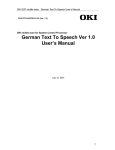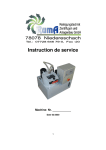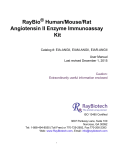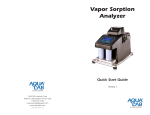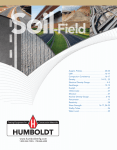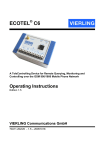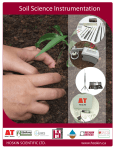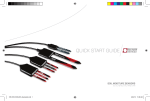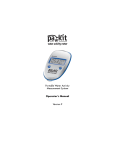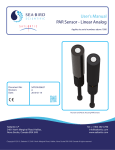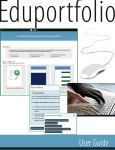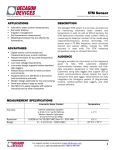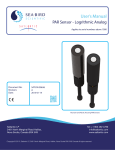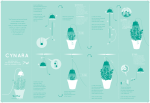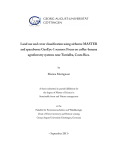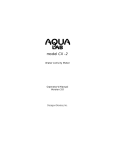Download Decagon Devices Inc. In House Style Sheet
Transcript
1 Writing and Content 1 Decagon Devices Inc. In House Style Sheet 1 Writing and Content App Notes: Feature a specific element of a product, be in functionality, capability, or area of interest. Operator’s Manuals: For all instruments, sensors, and physical products. Operator’s Manuals should be penultimate source for information on products. Should not be supplements to other publications, but the primary source of information for customers. Preferred Section Outline Section 1: “Introduction,” mostly prepackaged. Customer Support, Warranty, Seller’s Liability. Section 2: “About the...,” Shipping Contents, specs, Section 3: Firmware, Menus, functions of device Section 4: Theory Section 5: Taking a Reading, info on utilizing the device. Section 6: Software Section 7: Maintenance and Troubleshooting Section 8: Declaration of Conformity Section 9: Appendicies... Quickstart Guides: Should be primarily illustrations and short cuts for topics. Should not have information that does not appear in the Operator’s Manual, should supplement the information in the operator’s manual primarily with illustrations and short helpful instructions. User’s Manual: For all software, applications, and virtual products. 2 Words AquaLab AquaLab DUO AquaLink Autocorrect COM Port 3 Document Formatting 2 Data Logger DataTrac 3 Dew Point capitalized in title, uncapitalized as a measurement. Drop-down Menu easy-to-use ECH2 O Email Handheld head-space HTML Internet Kimwipe loss-on-drying Mini Disk Infiltrometer Online Quick Start Guide re-: Prefix added to words. DO NOT USE, unless it is really a word. That vs. which: Use “That” with essential clauses and do not preceded with a comma. Use “Which” with nonessential clauses and preceded with a comma. Through not Thru e.g. Follow steps 1 through 8. Setup noun or adjective when referring to computers and their setup. e.g. Go to the setup screen. [adjective] This PC setup is rather odd. [noun] Set-up This is the main noun ‘the set-up.’ e.g. The device set-up is difficult. Set-up main adjective, referring to things which are not the above ‘computers and their setup.’ e.g. The bank account attracted a 10 set-up fee. The set-up time was extremely short. Set up, This is the verb “to set up.” e.g. You must set up your computer. Subchannel Submenu Toolbar URL USB-to-Serial Yagi Antenna 3 Document Formatting Abbreviations: Avoid abbreviating common words such as information (info), page (pg), prerequisite (prereq), number (no) and professor (prof) 3 Document Formatting 3 in running text. Only abbreviate words if they are used in a format with minimal space, such as in a chart or table. A few common abbreviations: • i.e. is short for id est and means “that is” or “in other words.” • e.g. is short for exempli gratia and means “for example.” • etc. is short for et cetera and should be used at the end of a list of items when two or more items have been omitted. • et al. is short for et alii and should be used at the end of a list of names when two or more people have been omitted. • ampersand (&) Do not use to replace “and” unless it is part of an official title, place or organization name. Bibliography/Citations: Format all entries in either footnotes or bibliographies in American Geophysical Union format. e.g. Gamon, J.A., Peuelas, J., Field, C.B., (1992). A narrow-waveband spectral index that tracks diurnal changes in photosynthetic efficiency. Remote Sensing of Environment, 41: 35-44. Gamon, J. A., Serrano, L., Surfus, J. S., (1997). The photochemical reflectance index: an optical indicator of photosynthetic radiation use efficiency across species, functional types, and nutrient levels. Oecologia, 112: 492-501. Gamon, J. A., Field, C. B., Fredeen, A. L., Thayer, S., (2001). Assessing photosynthetic downregulation in sunflower stands with an optically based model. Photosynthesis Research, 67: 113-125. Garbulsky, M.F., Peuelas, J., Gamon, J., Inoue, Y., Filella, Y. (2011). The photochemical reflectance index (PRI) and the remote sensing of leaf, canopy and ecosystem radiation use efficiencies: A review and meta-analysis. Remote Sensing of the Environment, 115: 281-297. Garrity, S.R., Vierling, L.A., Bickford, K., (2010). A simple filtered photodiode instrument for continuous measurement of narrowband NDVI and PRI over vegetated canopies. Agricultural & Forest Meteorology, 150: 489496. 3 Document Formatting 4 Garrity, S. R., Eitel, J. U. H., Vierling, L. A., (2011). Disentangling the relationships between plant pigments and the photochemical reflectance index reveals a new approach for remote estimation of carotenoid content. Remote Sensing of Environment, 115: 628-635. Hilker, T., Coops, N. C., Hall, F. G., Black, T. A., Wulder, M. A., Nesic, Z., Krishnan, P., (2008). Separating physiologically and directionally induced changes in PRI using BRDF models. Remote Sensing of Environment, 112: 2777-2788. Buttons: Capitalize unique buttons, place in quotation marks on the first reference only. Common buttons, like Enter, Save, New, Export, have no quotations. Capitalization: Capitalize buttons, tabs, and labels, no all caps. Contact Information:Phone Numbers: ###-###-#### PTT products should direct customers to 509-332-5600/[email protected] and AG products should be 509-332-5601 and [email protected]. Cover(Pages): The front cover of all manuals should be formatted as follows. First center all items, begin with the name of the sensor, then any subtitles, follow with an illustration of the sensor, the words “Operators Manual,” the manual version, and the Decagon logo. Use LaTeX template for cover creation. Figures, Tables, Graphs: Refer to all figures in text specifically by number; not with the figure below or above, the following figures, etc. No in text reference, no figure. Place captions on top of Tables and below figures. Single spaces between all tables and figures. In text parenthetical refrence citations should look apper with only Section and Number. i.e. (Section 2) File Names: Refer to file types as PDF, DOC, BMP, etc. Headers and Footers: Duplexed, LaTeX standard format Lists: Bulleted lists should have no periods, must emphasize nouns, not sentences. Numbered lists may have periods, e.g. for instructions. 3 Document Formatting 5 Notes and Cautions: All notes should be in italics, with one space both on top and bottom. Cautions should be all bold. Product Names and “The” Do not use The at the beginning of the sentence when referring to a product. (i.e. The Truedry, The Em50), but use the for all in sentence Screen Shots: • Firmware Screen Shots: Screen shots are the only figures that do not require captions, however you must refer to them by name, not location. “The Measurement screen”, not “the screen below.” • Software Screen Shots: Require label, otherwise format as any other figure. Structure (Chapters and Subsections): Do not only assign one sublevel to a topic, e.g. Do not use 2.2.1 with no 2.2.2. LaTeX will determine the spacing between sections. Refer to groups of chapters or subgroups within the chapter as the “section,” do not refer to the standard chapters as sections. Structure (Chapters, First): Contains contact information, manual description, warranty information, and the standard Seller’s Liability snippet. Specifications: Use underlines only for broad categories in the product specifications. Specs always in list form, with no bullets or numbering. Do not underline anything else but specifications, all other items should be in bold. Units of Measure: Space between units and number, no period after space abbreviation. Decimals must match up in ranges. e.g. .1-4.0 in, 1-4 ft, or .01 -4.00 mi. Change all mm lengths to cm. Wind Direction vs Temperature: Wind Direction denoted with degrees as word, Temp denoted with circle symbol. Endashes: To be avoided, but useful when necessary for spacing issues. Preference is to spell out word to, i.e. 0 to 50. 4 Editing 6 Dimensions: Format dimensions with multiplication sign and not x, i.e. 5 x 9 x 10 bad, 5 × 6 × 9 good. 4 Editing Goals: • Neatness • Clarity/Precision • Consistancy • Zero Defects Editing Checklist 1. Check for present tense, active voice, and correct use of possessive nouns. 2. Remove unnecessary words, contractions, and dangling modifiers. 3. Avoid excessive lists, text emphasis, or confusing formatting 4. Use gender-neutral wording. 5. Define acronyms and abbreviations only at first mention. 6. Check for subject/verb agreement. 7. Use abbreviations and other terminology consistently. 8. Checked misspelled words (do not rely solely on a spell checker). 9. Checked for correct use of punctuation. 10. Refer to figures, tables, and appendices by their names, not location. e.g., say figure 1, not the figure below, etc. Make sure that all figures are as close as possible to in text references. Emphasize figures in text, avoid excessively long captions. 5 Specification Units 7 11. Bulleted and numbered lists have parallel construction and consistent punctuation. 12. Heading levels follow sequentially. If you want to create a subsection, you must have at least two sections that fall under it. For example, do not create heading 1.1.1 without a heading 1.1.2. If information for only one subsection exists, it should all appear under the main heading, 1.1. 13. Pagination is correct (for example, if sections are numbered 1-x, 2-x, etc., each section starts on page x-1). 14. Glossary identifies all key terms. 15. Updated and validated Table of Contents and Index entries. 16. Title page lists the title, authors, volume number, date according to standard format. 17. Attached sign-off sheet with comments and date that revisions are due. 5 Specification Units Tab. 1: Measurement Units Measurement Type Water Content Plant Available Water Water Potential Relative Humidity Measurement Name Units Dielectric Permittivity εa Volumetric Water Content m3 /m3 Percent Volumetric Water Content % Volumetric Water Content IPF Volumetric Water Content (cm/m) Plant Available Water % Water Potential kPa Water Potential Bar Suction pF Relative Humidity Hr or RH % Relative Humidity % Water Activity aw or Aw Vapor Pressure kPa Continued on next page 5 Specification Units 8 Table 1 – continued from previous page Measurement Type Measurment Name Units Heat Heat Joule, BTU, or cal Heat Flux Density W/m2 Thermal Conductivity W/m◦ K Thermal Resistivity m◦ K/W Specific Heat J/kg◦ K Diffusivity mm2 /s Diffusivity m2 /s ◦C Temperature Celsius Temperature ◦F Farenheit Temperature Drainage Drainage mm Drainage in Cumulative mm Cumulative in Precipitation Precip mm Precip in Bulk EC Electrical Conductivity dS/m Electrical Conductivity mS/cm Electrical Conductivity µS/cm Pore Water EC Pore Water dS/m EPore Water mS/cm Pore Water µS/cm Volume Liters L Cubic Meters m3 Gallons (US) US Gallons Cubic Feet ft3 Milliliters mL Wind Speed Wind m/s Wind km/h Wind mph Wind Gusts Gusts m/s Gusts km/h Gusts mph Leaf Wetness Minutes Wet (450 thresh) min Minutes Wet (460 thresh) min Water Level Water Level cm Water Level in Continued on next page 5 Specification Units 9 Table 1 – continued from previous page Measurement Type Measurment Name Units Misc. Measurements Millivolts Millivolts mV Solar Radiation Solar Radiation W/m2 PAR/PPFD Photosynthetic Photon Flux Density µmol/m2 s Switch Minutes Switch On min Pulse Pulse Count Pulses ◦ Direction Wind Direction Counts Counts counts ET0 Reference Evaportranspiration mm GDD Growing Degree Day GDD DLI Daily Light Integral mol/m2 d VPD Vapor Pressure Deficit kPa Chill Hours Chill Hours Chill Hours VWC Delta VWC Delta m3 /m3 Groundwater Depth Groundwater Depth mm Battery % Battery % RSSI Radio Signal Strength RSSI










